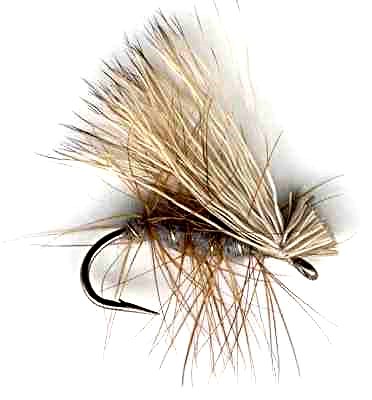Gray Elk Hair Caddis (Sedge) Fly
I can always remember my first introduction to fly fishing for trout using Elk Hair Caddis flies. At the village pub one summers evening a friend of mine had been telling tales of the great sedge hatches on the lake near his house.

CADDIS FLY PATTERNS. Hook size 10 12 14 16 18 20 - $US each
I expressed an interest to try this style of flyfishing and he invited me to have a try the following evening. He told me to meet him at 9pm. I felt this was a bit late but I turned up on time anxious to get started. He did not rush. There was barley an hour left of daylight. Because Britain is so far north in the summer it doesn't get dark until 10 o'clock. When we got to the lake it was flat. Nothing was moving. I was a bit disappointed. Grannom caddis sedge fly We rowed the boat upwind of a broadleaf weed bed. He told me to wait and watch. For about 15 minutes nothing stirred. I was so impatient to get my rod out and try a few casts before we lost the light. Out of the corner of my eye I detected movement. About 40 yards downwind the first adult caddis flies were starting to emerge and scutter towards the weed beds and relative safety. This woke up the trout. The next batch to hatch were attacked in a wild feeding frenzy. We put the boat within striking distance and caught fish after fish for the next two hours with the aid of moonlight. Try letting the fly sit stationary on the water surface and just give it a little tweak. If that fails skating the fly across the surface very fast by pulling the line with the left hand and at the same time raising the rod. Make sure you do not raise it more than 60-70 degrees from the horizontal or you will be in danger of having no room left to strike. After each retrieve lower the rod about 10 degrees and recover the line. Be prepared for strikes when the fly is moving not just when it stops

When fishing from a boat try to do what is called a re-float, gently lifting the rod tip and just letting the fly skip back towards you for a few feet while staying awake for a strike at any moment. Often the trout jump out of the water and down onto the fly causing many fisherman to try setting the hook before the fish has the fly in it's mouth. A re-float is done by picking the fly rod tip up after caddis fly is on the water. This gently skips the fly back towards you. Now lower the rod tip and once again lets the fly drift. Besides imitating the natural habit of a caddis laying eggs on the water, it increases the time spent fishing instead of casting resulting in much more water covered and fished by the fly.

Fly Fisherman Al Troth designed the popular Elk Hair Caddis dry fly
CUSTOMER'S COMMENT
One must go with what is going on at the time, however I should mention I fish streams in Western USA (mainly Utah, Wyoming, Montana, Idaho, California) and if I was to pick a failsafe fly it would be the elk hair caddis in the 20 to 24 range. Willian E Schlater, California, USA
CUSTOMER'S COMMENT
I fly fish for caddis in early June to early September in Minipi, Labrador in Canada. I use your elk hair caddis from hook size 16 to 12. John Brook
LINKEDIN COMMENT
I have great success with a Elk Hair Caddis on top and a Partridge Orange, or Green trailing about 18 inches below. I will cast at a 45 degree angle across and down stream towards the bottom of a long riffle run. As the flies reach the end of the drift I will swing them through the riffles. One of my favorite hatches is a good solid Caddis hatch. Will Goode
LINKEDIN COMMENT
In New Zealand I fish my favorite tan caddis a lot. We have many huge brown trout in the Tongariro river, only a 10 minute walk from my house in Turangi, and stalking along the bank with a caddis will get you awesome takes. Evening rises are wild....I use two flys, a caddis dry about # 12, with an emerger or a brown beetle trailing. Louie the fish DeNolfo
Fly Fishing books




